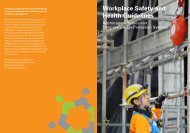Confined Spaces - Workplace Safety and Health Council
Confined Spaces - Workplace Safety and Health Council
Confined Spaces - Workplace Safety and Health Council
- No tags were found...
Create successful ePaper yourself
Turn your PDF publications into a flip-book with our unique Google optimized e-Paper software.
7.10.2 Forms of Hazardous EnergyEnergy sources can come in many forms but not limited to electrical, mechanical, hydraulic,pneumatic, chemical, thermal, gravitational, ionising <strong>and</strong> non-ionising radiation. It is necessary toisolate all mechanical, electrical equipment <strong>and</strong> all other energy sources connected to a confinedspace to prevent them from unintentional activation. If gases or vapours can enter the confinedspace, physical isolation of pipelines, valves, <strong>and</strong> so on needs to be locked <strong>and</strong> tagged usinglockout <strong>and</strong> tagout procedures. In all cases, a check is required to ensure isolation is effective.7.11 General Requirements7.11.1 Openings of <strong>Confined</strong> <strong>Spaces</strong>Before an entrance cover is removed, any known unsafe conditions shall be eliminated. Whenentrance covers are removed, the opening shall be promptly guarded by a railing, temporarycover, or other temporary barrier. This will prevent anyone from falling through the opening. Thebarrier or cover shall prevent foreign objects from entering the space <strong>and</strong> protect each employeeworking in it. If it is in a traffic flow area, adequate barriers shall be erected to divert the traffic.It is necessary to take precautions when opening the covers to tanks <strong>and</strong> within other confinedor enclosed spaces in the event the space is under pressure or hazardous materials have leakedfrom internal piping systems. It is important to leave at least two nuts on opposite sides of thecover in place until the cover can be cracked <strong>and</strong> any internal pressure has released.7.11.2 BarricadeIt is essential to use safety barriers to separate workers from hazards that cannot be reasonablyeliminated by other engineering controls. Selection of suitable barriers will depend on thenature of the hazard <strong>and</strong> the size of the area or equipment to be cordoned off. The supervisormust determine if safety barriers will be needed for the confined space entry prior to any workersentering the confined space.7.11.3 Communication/Warning SignsWarning sign/s can be used to inform workers about the confined spaces. It is critical for theworkers to know the location of the confined space, its hazards, the required safe work procedures<strong>and</strong> permit to enter the confined space.For details on specifications for graphical symbols on safety colours <strong>and</strong> safety signs,kindly refer to Singapore St<strong>and</strong>ard, SS508-2 : 2008 <strong>and</strong> SS508-4 : 2008.7.11.4 <strong>Confined</strong> Space Attendant (CSA)CSA should be appointed where any person enters or carries out any work in a confined space<strong>and</strong> remain outside the confined space to:• Monitor persons entering <strong>and</strong> working in the confined space;• Maintain regular contact with the persons in the confined space <strong>and</strong> when necessary assistthem to evacuate should the need arise; <strong>and</strong>• Alert the rescue personnel to activate the rescue operation in an emergency.7.11.5 Access <strong>and</strong> EgressWhere the possibility for inadvertent or unauthorised entry to a confined space exists, it isrequired to use appropriate means to prevent such an entry (e.g., a barrier or safety warning signthat is clear, legible <strong>and</strong> visible).A safe way in <strong>and</strong> out of the confined space should be provided for the individuals carryingout the work. Wherever possible, quick, unobstructed <strong>and</strong> ready access <strong>and</strong> egress should beallowed. It is essential that the means of escape be suitable for use by every individual whoenters the confined space so that he or she can escape quickly in an emergency.The size of openings used for access to <strong>and</strong> egress from confined spaces needs to be adequateto allow ready passage. Openings providing access need to be sufficiently large <strong>and</strong> free fromobstruction to allow the passage of persons wearing the necessary protective clothing <strong>and</strong>equipment, <strong>and</strong> to allow adequate access for rescue purposes. These openings need to bekept clear whenever a confined space is occupied. Where practicable, it is necessary to havean alternative opening for insertion of hoses, ventilation ducts, power lines <strong>and</strong> other cablesrequired for the work.Certain confined spaces may have design deficiencies which increase the level of entry risk toan unacceptable level. These include spaces whose openings are too tight for safe passage orwhich are of convoluted construction, or which involve excessive distances to a point of escape.Structural modifications (e.g., the making of temporary openings) will be necessary before entryis possible in these cases.<strong>Confined</strong> spaceNo unauthorised entry7.11.6 Display of Name <strong>and</strong> Identification BadgeThe person entering a confined space must display his name <strong>and</strong> identification badge at theentrance to the confined space. It is also the duty of the responsible person of the entrant toensure that he does the same.Figure 4: Examples of <strong>Confined</strong> Space warning signs.24 25
















